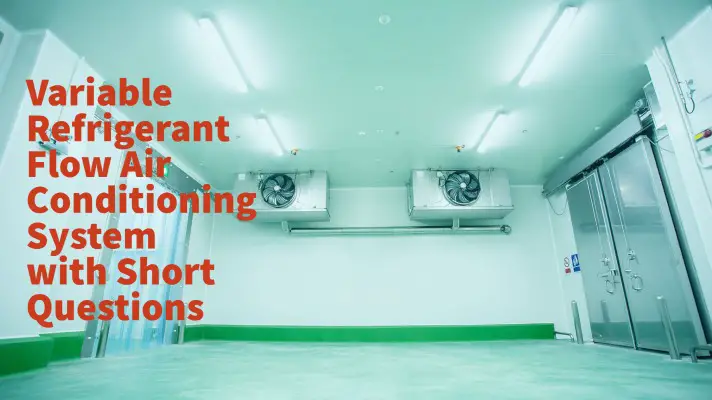Hello Readers! I hope that all of you are doing fine. I am here with some Short Questions on VRF AC System. Also, you will come across the Working Principles of the VRF AC system. At the end of the article, you will come to know what is VRF AC system, how it works, differences between Split Air Conditioner and VRF AC System through some short questions. Let’s enjoy gaining more knowledge!
Further for getting the PDF version of this Short Question sheet in hand, click on the PDF downloadable button that you will get at the end of this article.
VRF unit is the alternative to multiple split units or chilled water AHU units. It can replace both systems while maintaining the required efficiency.

What is the range of capacity of VRV Units?
Ans: 3 Tr to 1000 Tr.
When will you propose VRF System?
When you need the following criteria to meet, you need to choose VRF System:
- The aesthetic look is a very important factor.
- Some rooms require heating whereas some rooms require cooling.
- Different rooms need different temperatures to be maintained.
- Lack of space.
If the above mentioned 4 criteria, you need to satisfy then you must choose VRF Systems.
What are the differences between VRV and VAV Systems?
The full form of VRV is Variable Refrigerant Volume whereas VAV stands for Variable Air Volume.
The name itself indicates that in a VRV system, the flow of refrigerant is varied as per the cooling requirement whereas, in a VAV System, the volume of air is controlled depending on the requirement.
VRV system is similar to the multiple split unit systems whereas the VAV system is similar to the central air conditioning system.
Through the expansion valve, the flow of refrigerant is controlled whereas in the Central AC, in the supply air duct coming from the AHU unit, a VAV box is mounted through which the amount of air thrown inside the room is controlled.
Why can’t you go for multi-split units instead of VRV units?
In the case of multiple split units, the units are not linked with each other as each indoor unit is having a separate outdoor unit. In the case of VRV units, there are multiple indoor units, but an outdoor unit is one or many (if standby provision is required). The outdoor unit is connected with all the indoor units through refrigerant piping. And sharing always becomes cheaper than that of an individual one.
For very few numbers AC areas, you may go for Multiple Split units. But if there are many areas on different floors with different temperature requirements, then you should go for VRV Unit. By controlling the refrigerant flow through the thermostatic expansion valve, you can change the room’s inside temperature.
What is VRF System?
VRF system or Variable Refrigerant Flow system is more advanced. In Railway stations where the occupancy in the waiting rooms and in the ticket counters is unpredictable, where the amount of CO2 is high due to high occupancy, the VRF system is the best option.
In the VRF system, there will be a CO2 Sensor, a temperature sensor so that it can sense the room inside CO2 level as well as outside CO2 level, and thus it can measure the difference. In the case of temperature also, it can measure the difference, and accordingly, it controls the refrigerant flow.
In the VRF system, there are multiple numbers of Indoor units and one or two numbers of outdoor units. Within the Indoor unit, there are evaporating cooling coils and expansion valves whereas, in the outdoor unit, there are compressors and condensers.
If you want to use the VRF System in the Green Buildings, you have to use the TFA unit with the Outdoor unit of the VRF system.
What is a combination ratio?
The combination ratio or CR is the ratio between the sum of the nominal capacities of Indoor Units and the nominal capacity of Outdoor units. It is good practice to keep the CR between 50% and 130%.
How does a VRF System work?
A VRF system completely depends on refrigerant whereas, in a chilled water-based air-conditioning system, cooling depends on both water and refrigerant. A VRF System has an inverter compressor. As a result, the compressor motor runs at different speeds and thus it saves energy.
What are the different types of VRF Systems?
There are two types of VRF systems – Heat pump VRF -2 PIPE SYSTEM AND Heat recovery VRF -3 pipe system.
In 2 pipe VRF System, both options of heating and cooling are possible but simultaneous heating and cooling are not possible. In the heat pump VRF System, the indoor unit acts as a condenser during heating and during cooling, it acts as an evaporator.
In 3 Pipe system or Heat recovery VRF system, each outdoor unit i.e. the condenser unit has a connection with the indoor unit through three numbers of pipes – a high-pressure gas refrigerant line, a high-pressure liquid refrigerant line, and a low-pressure gas suction line. When the indoor unit serves for heating, it is connected with a heat recovery unit through a high-pressure gas refrigerant line. In this phase, the indoor unit acts as a condenser instead of an evaporator. In a heat recovery VRF System, simultaneous heating and cooling are possible.
What are the differences between VRV and VRF?
In 1982, Daikin Industries invented the VRV system. They do the copyright of this term. So, other industries use the same technology with a different name i.e. VRF. Actually, both systems are the same.
What are the differences between VRF and Split AC or indicate the advantages of the VRF System over Split AC?
Advantages of VRF System over Split
In the case of a VRF System, you can control the temperature precisely, you can cool and heat the air simultaneously in the rooms depending on their requirement. VRF/VRV system is more energy efficient than the Split AC system. You can control the humidity in the case of the VRF/VRV System but in Split AC you can’t.
VRF Vs Split AC cost
VRF Vs Split AC Power Consumption
The running cost of Split AC is more than that of the VRF System as the VRF system operates on the principle of the Room’s actual requirement based on their present condition. Split AC can’t sense the room’s requirements. But at the same time, the initial cost of the VRV unit is higher than that of Split AC. It is because of associated accessories like CO2 Sensors, Temperature sensors, etc.
Conclusion
I hope that you all have enjoyed the article on VRF AC systems. This will surely help you in cracking the interviews for Jobs. If you want to work on HVAC systems, then these questions and answers regarding VRF AC systems will surely help you. I wish you all the best!


